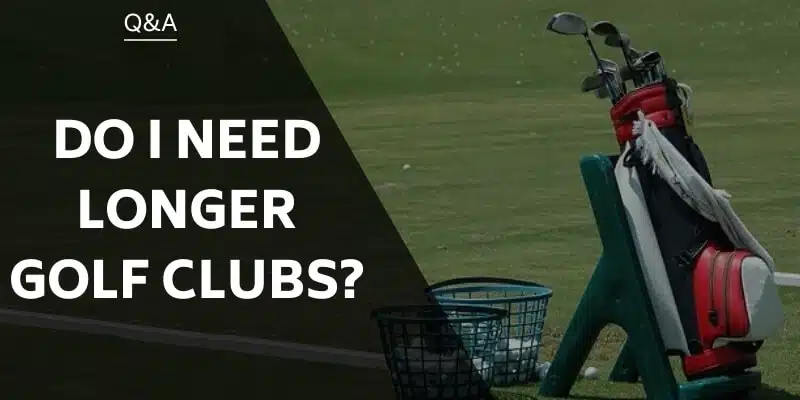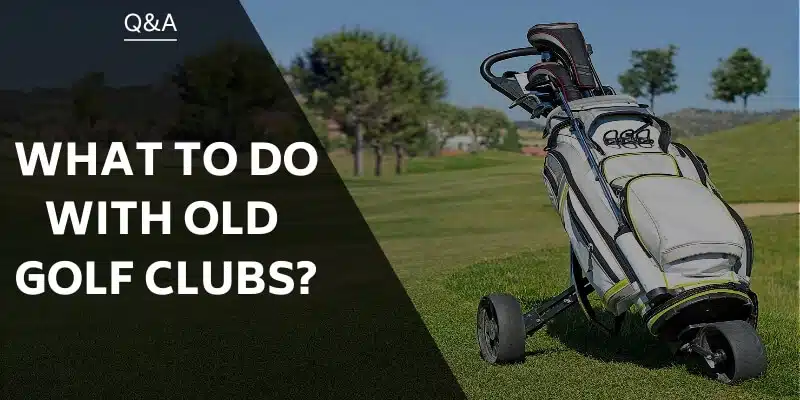The golf club lie angle is the angle between the club shaft and the clubhead soled flat on the ground. But let’s be more specific.
What is a golf club lie angle? Lie angle is the measurement between the center of the shaft and the ground when the sole of the clubhead rests flat on the ground. The standard lie angle for irons is between 59 and 64 degrees. Lie angle varies by a golfer’s height, swing, and preference. Having the right lie angle helps you hit more accurate shots.
But there is more to discuss regarding a club’s lie angle than that simple definition provides. My goal in the following article is to share everything you need to know regarding the lie angle of a golf club.
I will cover the following:
- What Is a Golf Club Lie Angle?
- The Importance of Golf Club Lie Angle
- A Standard Golf Club Lie Angle Chart
- How To Use A Lie Angle Chart Based On Height
- Lie Angle Charts According To Specific Golf Clubs Manufacturers and Brands
So let’s get into it and give you the long and short of everything lie angle-related in golf!
What Is A Golf Club Lie Angle?
Lie angle is the measurement between the center of the shaft and the ground when the clubhead’s sole rests flat on the ground. Simple, right? Well, it’s actually a bit more complex.
Standard lie angles for irons tend to range between 59 and 64 degrees.
Your right lie angle will depend on your height and the length of your arms. Your swing tendencies and ball flight will also play a part in determining what lie angle suits you.
Additionally, the standard lie angle varies from manufacturer to manufacturer, as you will see later in this article.
This may sound complex, but getting the right lie angle can definitely help you make more accurate shots, so it’s worth figuring out what works best for you.
Pro tip to measure your lie angle: To ensure your club is soled squarely on the ground look at the groves on the clubface. If they are parallel to the ground, your club is soled correctly.
Check this out: Best Golf Club Loft and Lie Machines & Buyers Guide
The Importance of Having The Correct Golf Club Lie Angle
There are many reasons why having a correct golf club lie angle for each of your clubs really matters. In all honesty, having clubs that fit you properly, with a correct lie angle, could make a massive difference in your game and ball striking.
Lie Angle Influences Your Shots Start Line
If your club is too upright, as a right-handed golfer, your start line will run left of your target. If your lie angle is too flat, your start line will be right of your target.
Lie Angle Influences Your Shots Shape
In addition to influencing your shot start line, lie angle influences your shot shape. The start line is one thing, but a more upright lie angle typically allows a shot to turn over and work right to left for a right-handed golfer. And, if you are following along, a more flat lie angle will typically allow you to work the ball more left to right.
Lie Angle Influences Your Interaction With The Ground at Impact
As we continue, other things will likely come to mind regarding the impact lie angle may have on your game. An example of additional influences is how your clubface may interact with the grass at impact. Suppose the lie angle is too flat; the result may be your toe catching the turf at impact. Or if the lie angle is too upright, your heel may catch the ground first at impact. I’m sure all of this information is starting to make a lot of sense to you now.
Read on: What Are The Degree Lofts Of Golf Clubs?
A Standard Golf Club Lie Angle Chart
Factors, such as a golfer’s height, play into determining the ideal lie angle for each individual.
| Club | Lie Angle | Loft | Length (Men) |
| 4 | 62 Degrees | 19.5 Degrees | 39 inches |
| 5 | 62.5 Degrees | 22.5 Degrees | 38.5 inches |
| 6 | 63 Degrees | 25.5 Degrees | 38 inches |
| 7 | 63.5 Degrees | 29.5 Degrees | 37.5 inches |
| 8 | 64 Degrees | 34 Degrees | 37 inches |
| 9 | 64.5 Degrees | 39 Degrees | 36.5 inches |
| PW | 65 Degrees | 44 Degrees | 35 inches |
| GW | 65 Degrees | 49 Degrees | 34.5 inches |
| SW | 65 Degrees | 54 Degrees | 34 inches |
Basically, the taller you are the lower your lie angle will be. Shorter golfers will have higher lie angles.
Again, the above are only fundamental ideas of what standards are for each club. These should not be considered the end all be all. Countless other aspects, such as height and wrist-to-floor measurement, which we will look at soon, factor in significantly.
More from Golf Span: How To Measure Driver Shaft Length (Images + Video)
Lie Angle Charts According To Specific Golf Clubs Manufacturers And Brands
As mentioned, not all golf club manufacturers have the same baseline lie angles. There are slight differences occasionally. I chose five popular sets of irons and plugged their lie-angle specs in the charts below to show you a few cases.
Srixon ZX7 Mk II Irons
| Club | Standard Lie Angle |
| 4 | 60.5 DEGREES |
| 5 | 61 DEGREES |
| 6 | 61.5 DEGREES |
| 7 | 62 DEGREES |
| 8 | 62.5 DEGREES |
| 9 | 63 DEGREES |
| PW | 63.5 DEGREES |
| AW | 63.5 DEGREES |
Taylormade P790 Irons
| Club | Standard Lie Angle |
| 4 | 61 DEGREES |
| 5 | 61.5 DEGREES |
| 6 | 62 DEGREES |
| 7 | 62.5 DEGREES |
| 8 | 63 DEGREES |
| 9 | 63.5 DEGREES |
| PW | 64 DEGREES |
| AW | 64 DEGREES |
Callaway Paradym Irons
| Club | Standard Lie Angle |
| 4 | 61 DEGREES |
| 5 | 61.5 DEGREES |
| 6 | 62 DEGREES |
| 7 | 62.5 DEGREES |
| 8 | 63 DEGREES |
| 9 | 63.5 DEGREES |
| PW | 64 DEGREES |
| AW | 64 DEGREES |
| GW | 64 DEGREES |
PING G430 Irons
| Club | Standard Lie Angle |
| 4 | 60.5 DEGREES |
| 5 | 61 DEGREES |
| 6 | 61.5 DEGREES |
| 7 | 62 DEGREES |
| 8 | 62.8 DEGREES |
| 9 | 63.5 DEGREES |
| PW | 63.5 DEGREES |
| 45.5 DEGREE | 64.1 DEGREES |
| 50 DEGREE | 64.1 DEGREES |
| 54 DEGREES | 64.4 DEGREES |
| 58 DEGREES | 64.6 DEGREES |
Srixon ZX5 Mk II Irons
| Club | Standard Lie Angle |
| 4 | 60.5 DEGREES |
| 5 | 61 DEGREES |
| 6 | 61.5 DEGREES |
| 7 | 62 DEGREES |
| 8 | 62.5 DEGREES |
| 9 | 63 DEGREES |
| PW | 63.5 DEGREES |
| AW | 63.5 DEGREES |
Great article from Golf Span: What Driver Loft Should You Use? (Full Chart Based On Swing Speed)
How To Use A Lie Angle Chart Based On Height
The process is straightforward in determining what lie angle is best for you based on your height and wrist-to-floor measurement. There are only about three steps to find the best setup for you.
Step #1
Measure your wrist to floor measurement as seen in the video below.
Step #2
With your measurements in hand, all you need to do next is take that number and your height and refer to the chart below.
So, for example, if you are 5′ 10″ and have a wrist-to-floor measurement of 32″, then the suggested lie angle for you would be 1 degree flat.
| Wrist to Floor | Height 4’ 10” to 5’ 6” | Height 5’ 6” to 6’ 2” | Height 6’ 2” to 6’ 7” |
| 40” | 3 Degrees Upright | 3 Degrees Upright | |
| 39” | 3 Degrees Upright | 3 Degrees Upright | 2 Degrees Upright |
| 38” | 2 Degrees Upright | 2 Degrees Upright | 2 Degrees Upright |
| 37” | 2 Degrees Upright | 2 Degrees Upright | 1 Degree Upright |
| 36” | 1 Degree Upright | 1 Degree Upright | Standard |
| 35” | Standard | Standard | Standard |
| 34” | Standard | Standard | Standard |
| 33” | Standard | Standard | Standard |
| 32” | Standard | 1 Degree Flat | 1 Degree Flat |
| 31” | 1 Degree Flat | 2 Degrees Flat | 2 Degrees Flat |
| 30” | 2 Degrees Flat | 2 Degrees Flat | 3 Degrees Flat |
| 29” | 3 Degrees Flat | 3 Degrees Flat |
Step #3
The last step is essential.
I recommend that you test different lie angles that are a half to even a full degree flatter or more upright than your recommendation via the chart. Use TrackMan, FlightScope, or another radar to test and compare data. In most cases, your wrist-to-floor measurement and height should give you a good recommendation. However, golfers have unique and individual nuances to their swings, which may only sometimes fit nicely into a chart.
FAQ
What Lie Angle Do I Need?
Your specific lie angles depend on your height and wrist-to-floor measurement. Additionally, you should test clubs with very slight differences from the manufacturer's recommendations for your height and wrist-to-ground measurements and see how a flatter or more upright lie angle works for you.
How Do I Know What Lie Angle I Need?
You can know your lie angle based on some factors.
* Height: Taller golfers typically need a more upright lie angle, while shorter golfers typically need a flatter lie angle.
* Swing: If you have a more upright swing, you will need a more upright lie angle. You will need a flatter lie angle if you have a more bent-over swing.
* Ball position: If you play the ball closer to your front foot, you will need a flatter lie angle. Playing the ball closer to your back foot will require a more upright lie angle.
* Clubhead design: Some clubhead designs are designed for a specific lie angle. If you are unsure of what lie angle your clubs are designed for, you can consult the manufacturer's specifications.
Do Shorter Golfers Need a Flatter Lie Angle?
Yes, shorter golfers typically need a flatter lie angle than taller golfers. This is because shorter golfers tend to have a more bent-over swing, and a flatter lie angle will help to ensure that the clubface is square to the target at impact.
What Lie Angle Do Most Pros Use?
Most pros use a slightly upright lie angle, typically between 1 and 3 degrees. However, their height and wrist-to-floor measurements generally determine their lie angle recommendations.
What is Lie Angle for Tall Golfers?
Tall golfers typically need a more upright lie angle than shorter golfers. This is because taller golfers tend to have a more upright swing, and a more upright lie angle will help to ensure that the clubface is square to the target at impact. If you are a tall golfer and unsure what lie angle is right for you, it is always best to consult with a golf club fitter. They can help you determine the correct lie angle for your height, swing, and other factors.
Final Thoughts
Understanding the lie angle on a golf club and how it can influence the outcome of shots you hit is essential to playing better golf. Additionally, understanding how to measure and find your ideal lie angle specifications is critical. The golf club lie angle chart I have proved and additional information should provide you with beneficial insight.
Not all manufacturers align with a standard lie angle for each club in the bag. While they may be very close to one another, a half or full degree of lie angle can make a difference in the shots you hit, so that is something to be aware of as well.
Brendon is Class A PGA Professional and founded Little Linksters, LLC, and its nonprofit arm, the Little Linksters Association for Junior Golf Development. He won 25+ prestigious industry honors, including the 2017 PGA National Youth Player Development Award. He graduated from the PGA of America Management Program and has a handicap index of 7.8.
He has played golf for over 40 years and currently plays twice a month at the Eagle Dunes Golf Club near Sorrento, Florida. He loves Srixon clubs and plays a ZX5 driver with Z 585 irons. He's written over 60 articles on GolfSpan and specializes in sharing tips to improve your golf game. You can connect with Brendon at LinkedIn, X, IG, FB, his website, or BrendonElliott@pga.com.
- Best score: 69
- Favorite driver: Srixon ZX5
- Favorite ball: Srixon Z Star
- Favorite food at the turn: Turkey and cheese on white










